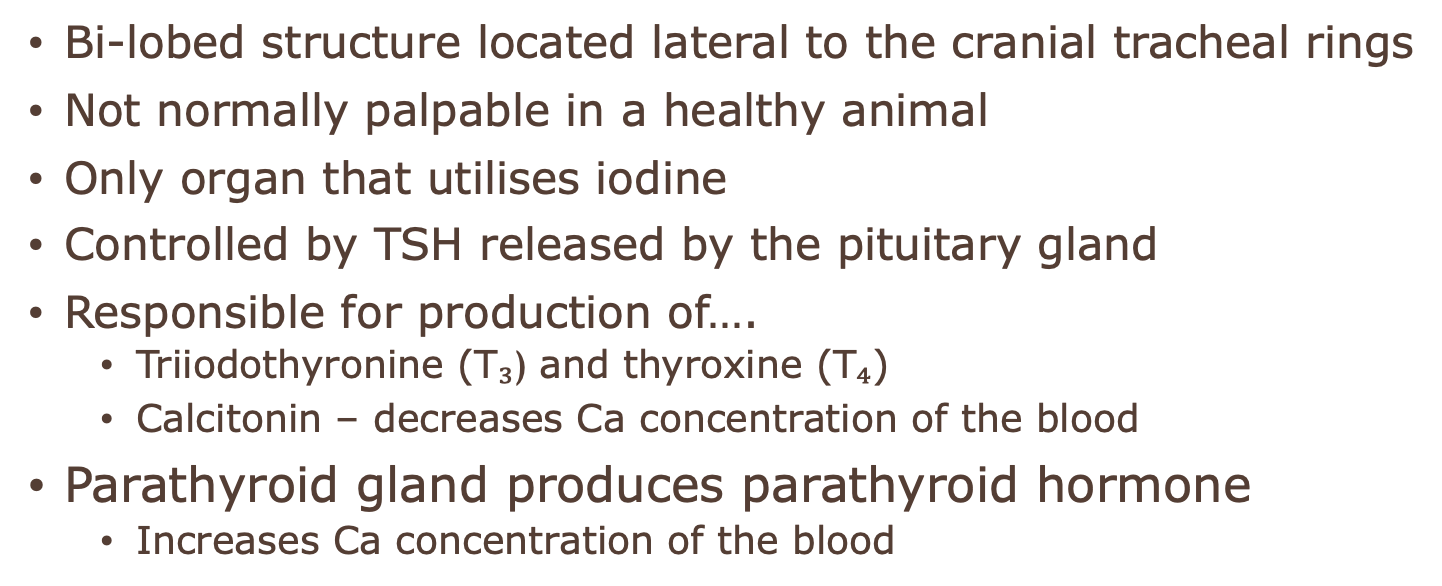8a. Endocrine System Disorders
1/5
There's no tags or description
Looks like no tags are added yet.
Name | Mastery | Learn | Test | Matching | Spaced |
|---|
No study sessions yet.
6 Terms
Thyroid Glands
•Bi-lobed structure located lateral to the cranial tracheal rings
•Not normally palpable in a healthy animal
•Only organ that utilises iodine
•Controlled by TSH released by the pituitary gland
•Responsible for production of….
•Triiodothyronine (T₃) and thyroxine (T₄)
•Calcitonin – decreases Ca concentration of the blood
•Parathyroid gland produces parathyroid hormone
•Increases Ca concentration of the blood

Hyperthyroidism
An overreactive thyroid gland - causes over-production of T3 and T4, which increases metabolic rates - cells in the body start to work harder and faster due to the overload
common in middle to old aged cats - both genders
clinical signs -
palpable enlarged thyroid
no matter how much they eat they don’t gain weight
heart murmur and tachycardia
polyuria and polydipsia - kidneys become overloaded - thirstier so urinate more
Diagnostics -
blood tests - including total T4
thyroid scintigraphy
Treatment - depends on severity, age, finance, facilities and patient behaviour
monitor vital signs
reduce stress
fresh water available
suitable diet
medication under VS direction
Hypothyroidism
An underactive thyroid gland
most commonly caused by auto-immune destruction of thyroid gland - decreased production of T4 leading to a decreased metabolic rate
Clinical Signs -
lethargy
obesity
bradycardia
Diagnostics -
blood tests
Total T4 and thyroid stimulating hormone assay
Treatment -
monitor vital signs
assist VS
fresh water available
feed a suitable diet - weight loss type diet (measure portions)
Adrenal Glands
located dorsally and cranially to the kidneys
Adrenal Medulla - adrenaline and nor-adrenaline - controlled by sympathetic nervous system
Adrenal Cortex - glucocorticoids
Hyperadrenocorticism - Cushing’s
Pituitary dependent hyperadrenocorticism -
Over-secretion of ACTH by the anterior pituitary gland (most likely due to a tumour).
ACTH is a hormone that stimulates the adrenal gland to produce glucocorticoids.
compression of the base of the brain and the optic nerves (can cause neurological issues and blindness)
Adrenal-based hyperadrenocorticism -
Adrenal tumour causes an over-secretion of cortisol.
Adrenal tumours are responsible for around 20% of the cases of canine Cushing's disease.
clinical signs -
Polyuria
loss of muscle tone
pot belly
panting
polyphagia - difficulty swallowing
Diagnosis -
abdominal ultrasonography
abdominal radiography
MRI / CT
general blood tests
Treatment -
fresh water available
oral medications
careful handling due to easily bruising
frequent toileting
Hypoadrenocorticism - Addison’s Disease
•Atrophy of adrenal cortex resulting in decreased production of glucocorticoids and mineralocorticoids
•Most commonly caused by auto-immune destruction of adrenal gland
•Lack of cortisol causes…
•Weakness, vomiting and anorexia (esp. when stressed)
•Lack of aldosterone causes electrolyte imbalances…
•Hyponatraemia (low sodium)
•Hyperkalaemia (high potassium)
Clinical signs -
lethargy
dehydration
V + D
coat changes
Diagnostics -
0 blood tests
ACTH stimulation test
ECG
Treatment -
IVFT
monitor vital signs
meds under VS direction
ECG
fresh water available